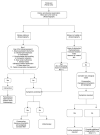Catastrophic complications of urolithiasis in pregnancy
- PMID: 34059543
- PMCID: PMC8169486
- DOI: 10.1136/bcr-2021-241597
Catastrophic complications of urolithiasis in pregnancy
Abstract
Urolithiasis is the most common non-obstetric complication in pregnancy and has the potential to cause grave consequences resulting in pregnancy loss. We present two such cases. First, a 24-year-old woman, 5 weeks pregnant with a history of urolithiasis presented with right flank pain and fever. She was found to have a right perinephric collection and during the course of her treatment suffered an abortion. The second case was a 25-year-old woman who presented in septic shock. She underwent emergency lower segment caesarean section elsewhere 10 days ago for intrauterine death at 38 weeks of gestation. On evaluation, she was found to have bilateral stone disease with a left subcapsular haematoma. Both the cases were managed conservatively and are planned for definitive management. Thus, women of childbearing age with diagnosed urolithiasis should get themselves evaluated and be free of stone disease before planning a family to prevent increased obstetric complications during pregnancy.
Keywords: abortion; reproductive medicine; urology.
© BMJ Publishing Group Limited 2021. No commercial re-use. See rights and permissions. Published by BMJ.
Conflict of interest statement
Competing interests: None declared.
Figures



References
Publication types
MeSH terms
LinkOut - more resources
Full Text Sources
Medical
